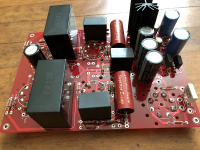Since you are so happy with this amp, why would you want to meddle with it and replace some of its caps with (probably) less suitable ones?
Remember the golden rule: if it ain't broke, don't fix it.
In case you are not convinced, search for recapping stories on the forum, it is edifying
Remember the golden rule: if it ain't broke, don't fix it.
In case you are not convinced, search for recapping stories on the forum, it is edifying
Safety caps: as their name implies, their key property is the ability to fail gracefully, and secondarily to damp RF perturbations. For these reasons, they use a peculiar construction, with a shallow metallization to ease the self-healing process and increase the losses.
Hi Elvee,
Could you recommend safety cap data sheets/descriptions showing their construction and properties? I'm keen to learn more - those safety caps I have used show excellent small small signal properties 10Hz to 20kHz and I'd like to understand their limitations.
Manufacturers like Siemens (now Epcos), Philips, Wima and others like Rifa (would you believe it!) used to publish white papers/information sheets on the subject.
They seem difficult to locate nowadays, but they must still exist somewhere in the limbo's of the net (nothing ever disappears, and with time and patience, you could still find everything).
Some examples:
https://www.vishay.com/docs/48251/_checklist_safety_caps_vmn_ms7357_1707.pdf
Safety | Engineering Center
If you can go past the paywall: Self-healing of capacitors with metallized film technology | Request PDF
Wikipedia also touches the subject:
Film capacitor - Wikipedia
https://www.icel.it/docs/2018/img_1af32843bb.pdf
https://www.mdpi.com/2079-9292/9/11/1893/pdf
http://robex.hu/uploads/files/quality_and_reliability_of_power_capacitors_EN.pdf
They seem difficult to locate nowadays, but they must still exist somewhere in the limbo's of the net (nothing ever disappears, and with time and patience, you could still find everything).
Some examples:
https://www.vishay.com/docs/48251/_checklist_safety_caps_vmn_ms7357_1707.pdf
Safety | Engineering Center
If you can go past the paywall: Self-healing of capacitors with metallized film technology | Request PDF
Wikipedia also touches the subject:
Film capacitor - Wikipedia
https://www.icel.it/docs/2018/img_1af32843bb.pdf
https://www.mdpi.com/2079-9292/9/11/1893/pdf
http://robex.hu/uploads/files/quality_and_reliability_of_power_capacitors_EN.pdf
Since you are so happy with this amp, why would you want to meddle with it and replace some of its caps with (probably) less suitable ones?
Remember the golden rule: if it ain't broke, don't fix it.
In case you are not convinced, search for recapping stories on the forum, it is edifying
Guess you missed when I wrote....
"purchased with the intent of upgrading it to learn more about SE amps"
The next model after this was the MS-300C. Widely considered a much better sounding amp. With a few mod's the B can come close. With the mods I have already implemented, I hope it will be even better. The B has global feedback, now on a toggle. Its also has local feedback, and this is also now on another toggle. (Made a huge difference in my PP) There is some debate as to the originality of the caps. Re-capped all with non-counterfeit factory specified values. The rectifier circuit had way too large of a capacitor in it, this lead to them going quickly. Fixed in mine now. The cathode bias resistor was way undersized for a 300B tube with B+ at 450v, causing the tube to be run with way too many mA. Fixed. Add to this, someone had made some repairs in it using dissimilar value capacitors between L and R, a few burnt resistors, a cold solder joint from yaquin and a few other "This shouldnt be like this" issues...
I am confident in my abilities. Almost nothing purchased or built from scratch cant be improved. While I have a very strong very basic knowledge of EE, I consider myself a good study. Im not spontaneous, and try to understand the ramifications of anything I do. All of this said, please let me know again, why would I want to settle ?
